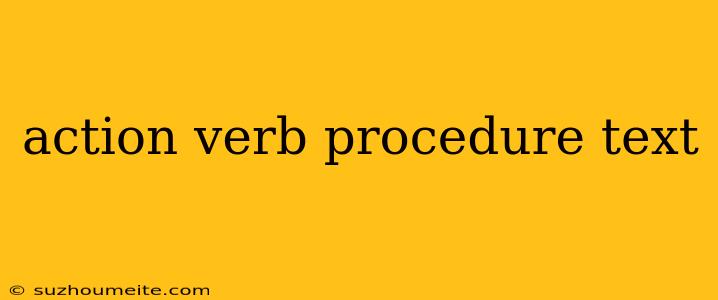Action Verbs in Procedure Texts: Making Instructions Clear and Concise
Procedure texts are designed to guide readers through a specific process, whether it's baking a cake, assembling furniture, or conducting a scientific experiment. To ensure clarity and efficiency, action verbs play a crucial role in these texts.
What are Action Verbs?
Action verbs describe actions, activities, or states of being. They are essential for conveying instructions and making the procedure text understandable. Some examples of action verbs commonly found in procedure texts include:
- Open: Open the box carefully.
- Remove: Remove the lid from the jar.
- Pour: Pour the ingredients into the bowl.
- Mix: Mix the ingredients until smooth.
- Bake: Bake the cake for 30 minutes.
- Assemble: Assemble the parts according to the instructions.
Why are Action Verbs Important in Procedure Texts?
- Clarity: Action verbs clearly indicate what needs to be done, leaving no room for interpretation.
- Conciseness: They are direct and to the point, avoiding unnecessary words and phrases.
- Ease of Understanding: Readers can easily follow the instructions by understanding the actions required at each step.
- Specificity: Action verbs help to ensure that the instructions are precise and tailored to the specific task.
How to Use Action Verbs Effectively in Procedure Texts:
- Use Strong and Specific Verbs: Choose verbs that accurately describe the action required, avoiding vague or general terms.
- Maintain a Consistent Tense: Use the imperative mood (e.g., "Open," "Remove," "Mix") to give a sense of command and direct the reader through the steps.
- Avoid Passive Voice: While passive voice can be used in some cases, active voice is generally more direct and easier to understand in procedure texts.
- Use Transition Words: Words like "then," "next," and "finally" help to guide the reader through the sequence of steps.
Examples of Action Verbs in Procedure Texts:
Baking a Cake:
- Preheat: Preheat the oven to 350°F (175°C).
- Grease: Grease and flour a 9x13 inch baking pan.
- Whisk: Whisk together the dry ingredients.
- Add: Add the wet ingredients to the dry ingredients.
- Bake: Bake the cake for 30 minutes.
Assembling Furniture:
- Unpack: Unpack the furniture parts.
- Align: Align the pieces according to the instructions.
- Screw: Screw the parts together using the provided screws.
- Tighten: Tighten the screws securely.
- Place: Place the assembled furniture in its desired location.
Conducting a Science Experiment:
- Measure: Measure the required ingredients carefully.
- Pour: Pour the ingredients into the beaker.
- Heat: Heat the mixture gently over a low flame.
- Observe: Observe the changes that occur during the experiment.
- Record: Record your observations and findings in a lab notebook.
By using action verbs effectively, you can create clear, concise, and easily understandable procedure texts that guide readers through any process efficiently.
